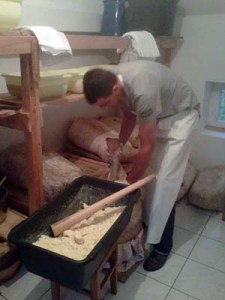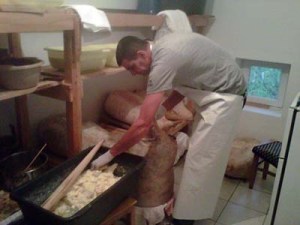This time Stefano Tesi takes the stand:
There’s a great difference between muttering about unfindable products known only through the adventuresome tales of others, and actually tasting them, perhaps after helping the local artisan make them.
The latter happened to me a few days ago, in a remote rural area near Nevesinje, in Bosnia-Herzegovina (in Herzegovina, to be exact, the southern part of the country), between Mostar and Gacko: I tasted the legendary sir iz mijeha, the cheese that is aged (and kept and transported and so on) in a sack made from a sheepskin.
Even overlooking a scenario built around authentic farmhouse hospitality, the cheese was excellent.
An important consideration, because, looking beyond the strictly gastronomic aspects, OXFAM Italia, the NGO that has been working for years in the region, hopes that the organized microproduction of cheeses (and other foods) might be one of the sparks that will help the unfortunate Balkan country rise up from the socioeconomic and institution necrosis it has suffered under since the end of the bloody war in 1992.
Indeed, in 2009 the Association of Sack Cheese producers was established (which now counts 42 members), and in 2010 the Center for the promotion of traditional local foodstuffs and aging of Herzegovinian sack cheeses was established. “A center,” says Silvana Grispino, Country Director of Oxfam Italia for BIH, “that will help cheesmakers produce their cheeses according to established standards, thus increasing the quality of the product, an aspect of vital commercial importance”
The “cheese in a sack,” which became a Slow Food Presidium in 2006, seems to derive from ancient traditions that were maintained until now on the one hand thanks to the cheese’s importance in the local diet, and on the other to characteristics that make its large-scale production impossible.
Sir iz mijeha is very pale yellow and has a moderately firm texture that, with aging (which can last from a few months to two years) becomes firmer, more crumbly, and drier. The sample I tasted, which has aged seven months, had powerful milky aromas that were well defined, sharp, but neither too penetrating nor too persistent. On the palate it was pleasingly salty, moderately firm, and with flavors that were intense and well defined, but not oversatiating, with a slight bitter underpinning and pleasant micrograininess.
In terms of cut and flavor (it’s eaten by the piece, or slivered, like Italian Grana cheese) it is quite tasty, and can be eaten as is, or with bread, or as an ingredient in some local dishes, for example cicvara, porridge made from fermented buckwheat flour and kajmac (a very rich milk cream); the cheese is added in pieces and allowed to partially melt thanks to the warmth of the pot on the stove.
.
Sack cheese is made from a mixture of raw sheep (the pramenka, an indigenous breed), cow and sometimes goat milk, in percentages that vary from cheesemaker to cheesemaker.
As soon as it has firmed up, the curds are broken into small pieces, recompacted, and pressed under a weight for several hours to eliminate the whey. After which the cheese is again broken up, salted, and pressed into the sheepskin to age. The sheepskin sack is opened and closed to allow the consumption of the cheese.
The most interesting aspect of the whole process is the preparation of the container. The skin is scraped clean and washed carefully several times, then tied securely at the ends and inflated — in the past with a bellows, and now with a bicycle pump. The resulting ball is hung to dry, and this does produce a certain scenographic effect. Once the skin has taken its shape, it is washed again and dried.
A skin can contain between 50 and 70 kilos (110-150 pounds) of cheese, and can be used once or at the most twice. But it is, if one thinks about it, a perfect example of recycling and putting discards to use.
In short, as is the case with pigs, here they lat no part of the sheep go to waste.
For further information on Sack cheeses, to contact the associations, or to arrange visits:
Okusi Hercegovinu | Stari most 1 | 88000 Mostar BiH | Tel.: +387(0)36554150-1 | Fax: +387(0)36552376 | info@okusihercegovinu.com | http://www.okusihercegovinu.com
Published Simultaneously by IGP, I Giovani Promettenti.
We Are:
Carlo Macchi
Kyle Phillips
Luciano Pignataro
Roberto Giuliani
Stefano Tesi




